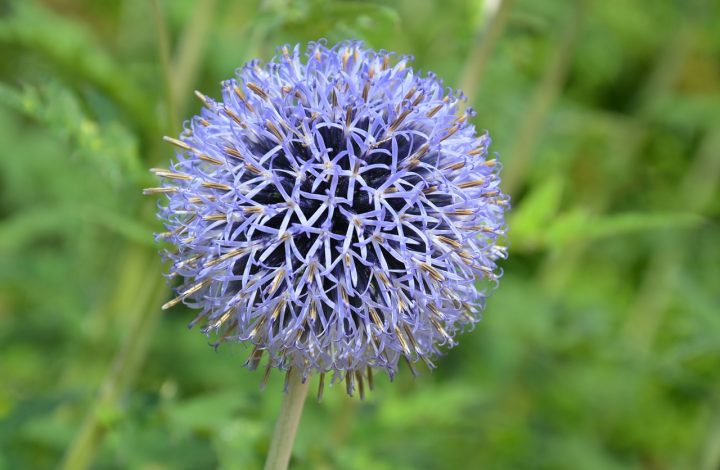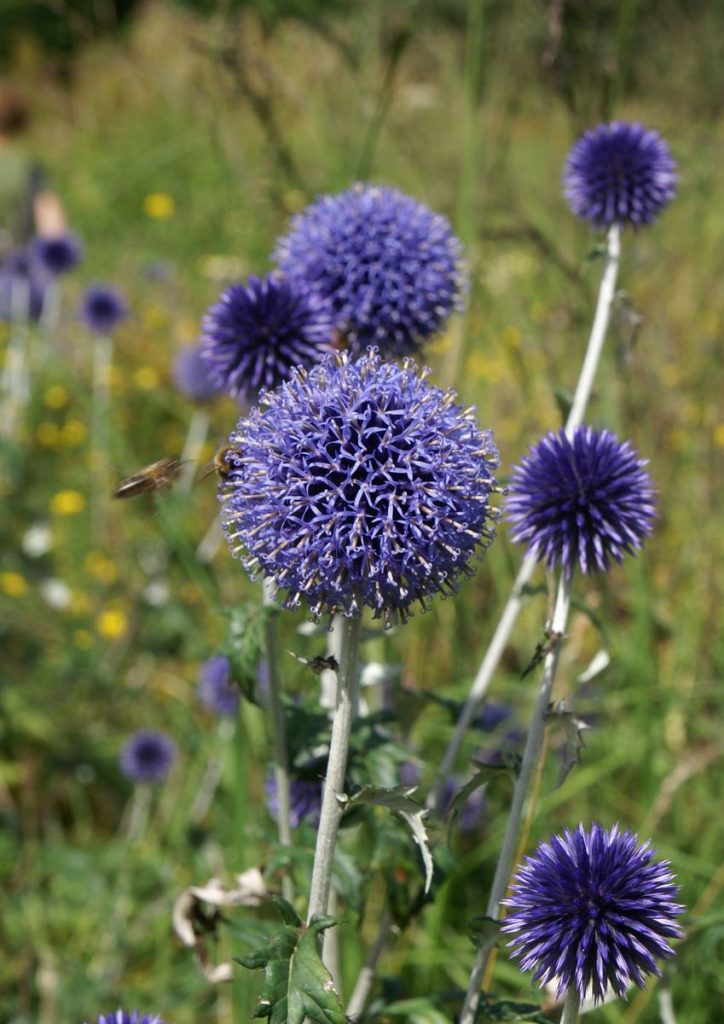KURDISTAN BOON: ECHINOPS
Porwal Omji.1*, Sheet M.A. M., Anwer T.E., Uthirapathy S., Ahamad J., Tahsin A.
| Prof. Dr. Omji Porwal
PhD., M.Pharm, PGDPRA Head of Department of Pharmacognosy Faculty of Pharmacy, Tishk International University, Erbil, Kurdistan, Iraq. https://ishik.edu.iq/pharmacy/resume/omji-porwal-2/ |
| Introductrion:
The genus Echinops, be the possession of the family Asteraceae (formerly Compositae) and muster ca. 120 natural taxonomic unit disseminate throughout the largest inland sea between Europe and Asia, Iraq, and in tropical Africa [1]. In Kurdistan Region of Iraq, this genus is represented by the very common species Echinops spinosus L. In consonance with the Kurdistan Iraq Plant Database, as well as the Plant List database, this name is synonymous with E. spinosissimus Turra [2–4]. It blossom in arid desert conditions with an annual rainfall varying between 20 and 100 mm, and has a wide ecological gamut for soil, including coastal, calcareous dunes, sandy, and gravelly to rocky surfaces [5]. Botanical assortment have subdivided Echinops spinosus L. into two subspecies [6,7]: E. spinosus ssp. eu. spinosus Maire (var. chaetocephalus Pomel) and E. spinosus ssp. bovei Boiss. |
|
| Fig: 1 Morphology of Echinops spinosus | |
| Maire (var. pallens Maire.), which is also known as E. bovei Boiss [8]. Recent data provided by synonymic consideration of the Cardueae (Compositae) genera database, validated the scientific name of E. spinosissimus subsp. bovei Greuter E. bovei Boiss [9]. | |
Three other natural taxonomic units have been reported in Kurdistan Region of Iraq, but appear to be not very common: a) E. ritro L., known under the name of “oursin bleu” or “echinops” in French, has a southern European dispensation, and occurs in southern Europe, western Asia, and even Siberia; b) E. sphaerocephalus L. is a mountainous taxonomic unit; and c) E. strigosus L. is distributed in the Iberian and North Africa area, especially in southern Spain and Algeria, and is widespread in the most western part of the Tell, from Tenes to the Moroccan border [6]. The pamphlets divulge that 24 taxonomic units of the genus Echinops have been exposed to varying degrees of scientific investigation [10]. Conversely, very little is known about E. spinosus [11, 12].
Botanical description and habitat:
- spinosus is a perpetual herb growing to 1 m and more, with erect brownish to reddish stems, few long leaves from 10 to 15 cm, hairy, arachnoids, and with very long spines. The efflorescence is often a single hemispherical globe up to 5 cm in diameter during the flowering period. It is surrounded with numerous long spines (Figure 1). The small hermaphroditic blooms that compose the dense head are tubular, turning from green to white and yellowish when in full bloom. The fruits are small achenes topped by membranous scales to ease dispersion [13]. In Kurdistan Region of Iraq, two very polymorphous subspecies have been described: 1) ssp. bovei (Boiss.) Maire: stems pubescent, not glandular. The achenes are composed into distinct pieces at the base. The leaves are whitish and woolly on both sides. E. bovei is a Southern Mediterranean-Saharan taxon, and is widespread in Algeria [14, 15]; and 2) ssp. eu. spinosus Maire: annual plant, upright and firm stems, from 40 to 60 cm. The distribution of E. eu spinosus is limited to the pre-desert regions in septentrional and central Sahara and is considered as a Saharo- Sindian taxon [6, 7].
Ethnobotanical aspects:
Traditional devise of E. spinosus are very often used in folk medicine as an abortifacient, as a diuretic, and for blood circulation, diabetes, gastric pain, indigestion, and spasmolytic problems [16].
In unadventurous medicine practices, E. spinosus is known in the Chinese [17] and North African traditions [18]; the latter reporting the ethnomedicinal use of the stems, leaves, and roots as a diuretic drug. In Algeria and some tribal areas of Kurdistan Region of Iraq, the roots or flower heads of E. spinosus have been used in the treatment of prostatism and dysmenorrhea. This botanical medication has also been used as a peripheral vasoconstrictor in the treatment of hemorrhoids, varicose veins, and varicocele, in various venous hemorrhages and in metrorrhagia. It is contemplate as a hypertensive drug [19, 20].
Conclusions:
The Information abridges the limited information on E. spinosus and highlights the therapeutic potential, which is used mainly as an anti-inflammatory drug in Kurdistan, Algeria, as well as in Morocco. To the best of our knowledge, no academic work has been conducted to chronicle the toxicological effects of this species. Therefore, further clinical studies, based on standardized extracts from a sustainable source, must be designed to ensure the well-being and efficacy of the extracts of this species which can be widely used in traditional medicine.
References:
- Halim AF, Afify MS, Ahmed AF, Mira AS. The fact about Echinopsine and first isolation of echinorine from Echinops spinosus J Environ Sci 2011; 40:173–81.
- Global Compositae Checklist. 2009. https://compositae.landcareresearch.co.nz/?Page=NameDetails&NameId=C9849136-01E5-4A6A-9860-F575 3930D8D7 (Accessed 11 March 2018).
- The Plant List. 2013. Version 1.1 Published on the Internet, https://theplantlist.org/ (Accessed 11 March 2018).
- African Plant Database. Version 3.4.0. Conservatoire et Jardin botaniques de la Ville de Genève and South African National Biodiversity Institute, Pretoria. https://ville-ge.ch/musinfo/bd/cjb/africa/ details.phplangue=fr&id=137404 (Accessed 11 March 2018).
- A guide of medicinal plants in North Africa. Centre for Mediterranean Cooperation, Malaga, Spain, pp 132–3, 2005.
- Quezel P, Santa S. Nouvelle flore de l’Algérie et des régions désertiques méridionale. Tome II. CNRS Editions, Paris, p 995, 1963.
- Ozenda P. Flore et végétation du Sahara. 3rd edition, CNRS Edition, Paris, p 446, 2004.
- Dobignard A, Chatelain C. Index synonymique de la flore d’Afrique du Nord. Volume 2, Editions des conservatoire et jardin botanique, Genève, p 258, 2011.
- Greuter W. The Euro+ Med treatment of Cardueae (Compositae)—generic concepts and required new names. Willdenowia 2003; 33:49–61.
- Abegaz BM, Tadesse M, Majinda R. Distribution of sesquiterepene lactones and polyacetylenic thiophenes in Echinops. Biochem System Ecol 1991; 19:323–28.
- Gheffour K, Boucherit K, Boucherit-Otmani Z. Etude phytochimique et évaluation de l’activité antioxydante des extraits d’Echinops spinosus. Rev Phytother 2015; 13(5):288–94.
- Boumaraf M, Benyahia S, Mekkiou R, Benayache S, Benayache F. Flavonoids from ethyl acetate extract of Echinops spinosus (Asteraceae). Der Pharma Chemica 2016; 8(8):158–60.
- Agyare C, Obiri DD, Boakye YD, Osafo N. Anti-inflammatory and analgesic activities of African plants. In: (eds). Medicinal plant research in africa pharmacology and chemistry. 1st edition, Elsevier, London, pp 725–52, 2013.
- Chermat S, Gharzouli R. Ethnobotanical study of medicinal flora in the North-East of Algeria—an empirical knowledge in Djebel Zdimm (Setif). J Mater Sci Eng A 2015; 5(1–2):50–9.
- Hammiche V, Maiza K. Traditional medicine in Central Sahara: Pharmacopoeia of Tassili N’ajjer. J Ethnopharmacol 2006; 105:358–67.
- Kheder O, Moussaoui Y, Bensalem R. Solvent effects on phenolic contents and antioxidant activities of the Echinops spinosus and the Limoniastrum monopeltatum. Research Journal of Pharmaceutical, Biological and Chemical Sciences 2014; 5(2):66–76.
- Parhat R, Makabel B, Nurhabek U, Tohonrbek A, Hayni, Song FF, et al. Overview of application and research of Echinops genus in Chinese medicine. Zhongguo Zhong Yao Za Zhi 2014; 39(19):3865–9.
- Boulos L. Medicinal plants of North Africa. Reference Publications Inc., Algonac, MI, p 286, 1983.
- Ait Youssef M. Plantes médicinales de Kabylie, Ibis Press, Paris, pp 117–9, 2006.
- Baba Aissa F. Encyclopédie des plantes utiles. Flore d’Algérie et du Maghreb, Librairie moderne, Rouiba, p 95, 2000.



